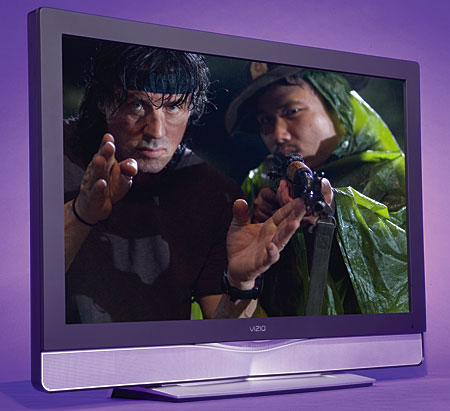Warehouse Wonders: Three LCDs Compared VIZIO VU42LF LCD HDTV
The VIZIO offers two HDMI and two component inputs, together with a VGA jack for a computer connection.
The picture controls include the usual suspects. An Advanced Video menu offers six additional video controls, all of which worked best, for me, in their Off positions.

The backlit, code-programmable remote can control three components plus the TV. It offers (nearly) direct selection of inputs. The AV, Component, and HDMI buttons switch to the first of these respective inputs on the first push and the second input on the second push. The dark-gray lettering on some of the buttons, however, can be difficult to read in dim room lighting. But the manual is superb, probably the best of the three here and one that other manufacturers would do well to emulate.
 The VIZIO’s video processing was about average overall. While it properly deinterlaced 1080i material to 1080p, it failed to recognize 3:2 pulldown, a common flaw in modern sets, especially at this price point. You probably won’t notice it with most material, but it can produce artifacts on complex 1080i material.
The VIZIO’s video processing was about average overall. While it properly deinterlaced 1080i material to 1080p, it failed to recognize 3:2 pulldown, a common flaw in modern sets, especially at this price point. You probably won’t notice it with most material, but it can produce artifacts on complex 1080i material.
The VIZIO’s color was reasonably accurate out of the box with its Color Temperature control set to Normal. The temperature was a little high, as much as 434K above the 6500K standard across most of the range, turning somewhat higher—bluer—at the very dark end. The overall color accuracy was good for an uncalibrated set, inexpensive or otherwise.
More important, the VIZIO’s color was pleasing. It was richly saturated, but not excessively so. Fleshtones could look just a little sunburned, even with the Color control turned down, but never enough to be distracting. The same goes for the slightly oversaturated greens, a common characteristic of many digital displays. But it was less obvious here than on many sets. Black-and-white material also looked fine, with no clearly visible uniformity issues or subtle patches of unwanted color.
The VU42LF’s measured resolution was excellent over HDMI at 1080i, although it was surprisingly rolled off through the component inputs. Its subjective detail was very good—arguably a carbon copy of the Westinghouse but slightly less detailed than the Sceptre. The difference was only clear when I performed a side-by-side comparison.
The VIZIO’s main shortcoming is its black level and shadow detail. The set’s contrast ratio was 748:1 (28.4 ft-L peak white, 0.038 ft-L video black), a middling result in today’s LCD market.
The upshot of these readings was that, of the sets here, the VIZIO had the most washed-out, grayish look in dark scenes.
The VIZIO does a lot of things well. On most material, it can hold its own with the other sets here, with good resolution, fine color, and a well-chosen gamma. (See Sceptre x42BV-FullHD: Geek Alert if the word gamma makes you scratch your head.) It has the widest acceptable off-axis viewing angle. But its black level, contrast ratio, and shadow detail are a bit behind the curve.


At press time, the VU42LF’s MSRP was $1,099, but it will be available for a street price of $999 by the time you read this.
Highlights
Best out-of-box color and off-axis performance
Good resolution
Least impressive blacks and shadow detail
- Log in or register to post comments



























































